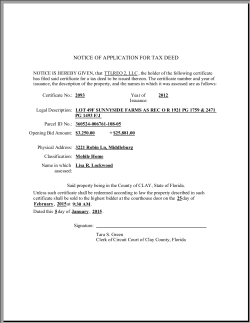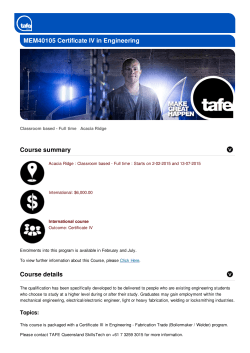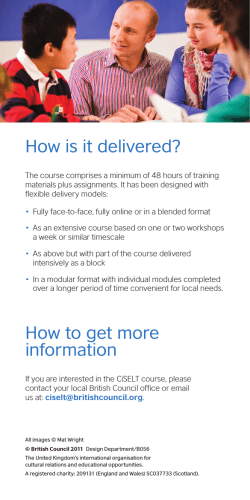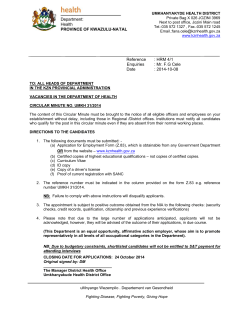
Standard 15 CC Workbook
The CARE CERTIFICATE Infection Prevention and Control What you need to know Standard THE CARE CERTIFICATE WORKBOOK Infection prevention and control Infection and infectious diseases in humans are caused when harmful germs, known as pathogens (or pathogenic micro-organisms), enter the body and grow. These micro-organisms are so small they can only be seen by using a microscope. Infectious diseases, unlike other diseases such as heart disease and diabetes, can spread from person to person. As with all illnesses, prevention is better than cure. By following agreed ways of working that stop the spread of pathogens can help to prevent and control infection. Pathogens A pathogen is something that causes a disease. Pathogenic organisms can be: Bacteria that can multiply quickly at body temperature and reach harmful levels very fast. Examples of harmful bacteria include meticillinresistant Staphylococcus aureus (commonly known as MRSA) and Clostridium difficile (known as C.Diff or C. Difficile). These two types of bacteria caused, or contributed to, 9000 deaths in hospitals or primary care in 2007. Viruses that can survive on surfaces and in food but can only multiply in living cells. It takes very few virus organisms to cause illness. They can be spread from person-to-person and from environment-to-food. Examples of viruses include Norovirus (also known as ‘winter vomiting disease’) and Influenza (the flu virus). Fungi are organisms which live on hosts that can be alive or dead. Examples of fungal infections include; athlete’s foot and ringworm. Parasites live on or in another plant or animal, known as the host. Scabies is caused by mites that burrow into the skin causing severe itching. Protozoa are single-celled organisms that live in water and damp conditions. Malaria is an example of a disease caused by protozoa. THE CARE CERTIFICATE WORKBOOK STANDARD 15 1 Hosts A host could describe the organism from which the parasite feeds or in which it lives or grows Some groups of people may be more vulnerable to infection, for example Because of age or ill or general health. If these groups become infected the symptoms may be serious and life-threatening. If the micro-organisms which cause the illness are resistant to antibiotics, it can be difficult to treat the illness. The chain of infection In order for the spread of infectious diseases to take place the ‘chain of infection’ must be completed. The first link in the chain is the causative agent. This is the harmful germ or pathogen that can cause infection, illness and disease. Examples include bacteria and viruses. The second link is the reservoir or source. This is where pathogens live and multiply. Remember, that could be in or on a person or animal (host), or in soil or water. The third link is the means of exit. This is how pathogens leave the source. For example, pathogens that live in the respiratory tract (the lungs, throat, etc.) can leave the body through the mouth or nose in saliva or mucus when coughing or sneezing. Other examples of means of exit are broken skin, mucous membranes such as the eyes, via the stomach and via the intestines and anus. The mode of transmission is the fourth link in the chain. It refers to how the pathogen is passed on from one person to another. Contact transmission is the most common route of transmission of pathogens in a health and social care workplace. This can happen by direct (hands) or indirect contact (equipment). Pathogens such as those that cause influenza and chicken pox can stay in the air for a long time and can be breathed in by other people. THE CARE CERTIFICATE WORKBOOK STANDARD 15 2 The fifth link is the portal of entry. This is the way that the pathogen enters the body of the potential host. Pathogens can enter the body by coming into contact with broken skin, being breathed in or eaten, coming into contact with the eyes, nose and mouth or, for example when needles or catheters are inserted. The sixth and final link in the chain is a person at risk. A person at risk is the individual the pathogen moves to. The risk of a person becoming infected depends on factors such as their general health and the strength of their immune system (which is the body’s system for fighting germs and micro-organisms). Breaking the chain Preventing infection means breaking the links in the chain so that an infection cannot spread. Some links are easier to break than others. For example, it is easier to stop a pathogen from entering a person than it is to stop one leaving an infected person. The steps taken to protect individuals and workers from infection are an important part of providing high quality care and support. It is vital to remember that not everybody who carries harmful micro-organisms will be ill or show any symptoms, so you must work in ways that prevent infection at all times. Standard precautions are the actions that should be taken in EVERY situation to reduce the risk of infection. These include: Good hand hygiene Safe disposal of waste Safe management of laundry Correct use of Personal Protective Equipment (PPE). In a workplace it may be necessary to take additional measures when supporting people who are known to be carrying some harmful microorganisms to protect others from contamination. This can be particularly important if the pathogens travel through air. Contamination If something becomes contaminated it means it will become dirty, infected, unclean or polluted. THE CARE CERTIFICATE WORKBOOK STANDARD 15 3 Your health and hygiene You have an important role to play in preventing the spread of infections. It is your responsibility to keep up to date with your own vaccinations in line with the UK vaccination schedule as it is part of your duty to protect the individual. If you are carrying pathogens, you can transmit them to the people you support directly or you can transfer them from other people or equipment if you do not follow correct hygiene procedures. Illness If you have cold or flu symptoms (such as a runny nose), an upset stomach or skin infections, you should speak to your manager before reporting for work. If you have diarrhoea or vomiting you should not attend work until you have been free from symptoms for 48 hours. Clothing Your clothes can become contaminated with harmful microorganisms. Disposable aprons and over-sleeves should be used when handling anything contaminated with body fluids to protect clothes from contamination. Changing your clothing daily reduces the risk of remaining contaminants being spread to the individuals you provide support for. Uniforms or work clothing should be washed on a hot wash, then tumble-dried or hot ironed, to kill any bacteria present. Skin health Micro-organisms can live on the skin. The number of pathogens increases when skin is damaged. All cuts should be covered with a waterproof dressing. Using hand cream, good quality paper towels and soaps can help to protect the skin. Personal hygiene Personal hygiene is extremely important for people who take care of others. Daily washing, showering or bathing will remove most of the microorganisms on your skin. Hand hygiene is also extremely important. Fingernails should be kept short. Rings (apart from plain wedding bands), wristwatches or bracelets should not be worn as they can make hand washing less effective. Good hand habits Having good hand habits means not touching areas that can be a source of pathogens more than you need to. These areas include your nose, hair and mouth, and not biting nails. This also applies to work practices such as using foot operated bins rather than lifting bin lids with your hands. THE CARE CERTIFICATE WORKBOOK STANDARD 15 4 Competence Hand washing is an area of your competence that is essential to ensure the health and wellbeing of yourself, the individuals you support and all others. 5 moments for hand hygiene Hand hygiene is an important part of preventing infection. Hands can be cleaned, or decontaminated by: Washing with water and soap that removes dirt and germs from the hands but doesn’t kill them Using alcohol hand rubs and gels which kill most bacteria. These are less effective against Clostridium difficile and some viruses that cause vomiting and diarrhoea if hands are visibly dirty. The World Health Organisation has identified ‘5 moments’ when health and social care workers should clean their hands. These moments are: 1) Before touching the individual you are supporting. 2)Immediately before carrying out a ‘clean’ procedure. 3) After exposure to body fluids and after removing gloves. 4) After touching the individual you are supporting. 5) After touching the area or objects surrounding the individual you are supporting. Hand washing For hand washing to be effective it is important that you make sure that every part of your hands are carefully washed, rinsed and dried. The steps below show you how to ensure that your hands are washed correctly: 1)First, wet your hands and wrists thoroughly using warm running water. 2) Apply liquid or foam soap. 3)Produce a good lather by rubbing your palms together, then interlock your fingers and rub together again. 4)Rub the palm of your hand ensuring that fingertips and fingernails are cleaned. Ensure that the backs of your hands are lathered and cleaned. 5)Rub with fingers locked, maintaining a good lather. Ensure that your wrists are cleaned. 6)Rinse hands thoroughly using running water. THE CARE CERTIFICATE WORKBOOK STANDARD 15 5 Hands and wrists should be thoroughly dried using paper towels or a hand dryer. Rubbing and lathering your hands should take around 20 seconds. Personal Protective Equipment (PPE) Your employer must provide you with the equipment you need to protect you from injury and, as far as possible, from the risk of infection while you are at work. That includes: Enough uniforms for regular changing and disposable aprons to protect clothing and uniforms from contamination from blood and body fluids etc. Skin protecting paper towels and soaps and hand cleansing gels or wipes The correct type of gloves to reduce the risk of cross-contamination of you and the individual you are supporting Masks and respiratory-masks to protect you from breathing in harmful microorganisms Goggles, eye protection and face shields – if there is a risk of being splashed with body fluids. It is also important that you appreciate and seriously consider any vaccinations your employer might offer as part of the prevention of infections spreading. One example might be the vaccination against influenza (flu). Safe handling of waste It is important that you understand how different waste should be handled safely to protect you, your colleagues and the people that you provide support for. Clinical waste is produced from healthcare and similar activities. It is placed in either yellow or orange plastic sacks. It should be kept separate from other waste and disposed of using specialist facilities. Clinical waste can be either hazardous (waste that poses or may pose a risk of infection for example, pads and dressings) or non-hazardous (which is non-infectious waste). Waste containers should be handled carefully to avoid contamination. Where appropriate you should use PPE to protect you from contamination and infection. Your employer should have a waste handling policy in place. This will detail how you should deal with different types of waste. You must make sure that you understand and follow this policy at all times. THE CARE CERTIFICATE WORKBOOK STANDARD 15 6 Safe disposal of sharps Your employer is responsible for providing the correct equipment and materials to reduce the risk of injury. They are also responsible for managing the risks of using sharps such as needles and blades, undertaking risk assessments where necessary. The following guidelines in relation to sharps should be followed: They must be disposed of at the point of use into an approved container All sharps bins should have the name of the person who assembled it and the date of assembly on the label. The same applies for the person closing the bin Do not fill bins past the ‘full’ line marked on the bin. Sharps can fall out and cause injury Use the temporary closure mechanism on the top of the bin when it is not being used, to prevent spillages if the bin is toppled over Always keep bins above floor level to prevent children from reaching them Store bins securely out of sight and reach of other people who may be present. If workers are transporting sharps by car, these should be kept in the car boot Do not pass sharps from one hand to the other Do not handle sharps more than is essential Do not put protective covering back on needles Do not bend or break needles Do not separate needles or syringes before disposal. THE CARE CERTIFICATE WORKBOOK STANDARD 15 7 Soiled linen Linen that comes into contact with workers or individuals can become contaminated with harmful micro-organisms and body fluids. Linen refers to anything that is made of cloth including bedding, towels and clothing. Personal protective equipment (PPE) must be worn when handling infected linen as it can transfer pathogens to skin and clothing. All infected linen (that is linen that is contaminated with body fluids) must be washed separately to other items. Clothing can be decontaminated in a 40°C-50°C wash followed by tumble-drying or hot ironing Bedding and towels should be washed in a hot wash to ensure that bacteria are killed Laundry should be moved to the washing area in sealed, colour coded bags When supporting an individual in their own home you should ask permission to wash infected linen immediately. Once linen has been decontaminated it must be stored separately from contaminated linen to prevent cross-contamination. You must always follow your agreed ways of working. If you have any questions about these you should speak to your manager. Agreed ways of working This refers to organisational policies and procedures. This includes those less formally documented by individual employers and the self-employed, as well as formal policies such as the Dignity Code, Essence of Care and Compassion in Practice. THE CARE CERTIFICATE WORKBOOK STANDARD 15 8 The CARE CERTIFICATE Infection Prevention and Control What do you know now? Standard THE CARE CERTIFICATE WORKBOOK Activity 15.1a In order to prevent the spread of infection you need to know how harmful organisms (pathogens) can get into the body. Describe the three main ways of how an infection can get into the body: Infection Prevention and Control Describe - to describe means to create a picture with words but not simply writing a list of bullet points. 1. 2. 3. THE CARE CERTIFICATE WORKBOOK STANDARD 15 10 Activity 15.1c Workers have an important role in preventing infection spread, not only because they can spread pathogens between individuals but also because they can host or carry a pathogen. Therefore workers should practise good personal and hand hygiene. Think of someone you support and use three examples to explain how your own health or hygiene might pose a risk to this individual: Explain - to explain something you will need to provide a clear account of your understanding including details like why and how. Some of these words might help you as headings: Illness Clothing Personal hygiene Skin health Hand hygiene THE CARE CERTIFICATE WORKBOOK STANDARD 15 11 Activity 15.1d The law says individuals should be provided with the correct materials and equipment to protect them from injury and, as far as possible, from the risk of infection while at work: List - this term means to identify the main points which can be written as bullet points. Complete the table below to list five examples of common types of personal protective clothing (PPE), equipment and procedures and how and when to use them. Type of PPE, equipment or procedure How and when would you have to use it? 1. 2. 3. 4. 5. THE CARE CERTIFICATE WORKBOOK STANDARD 15 12 Activity 15.1e Handling infected waste and soiled linen in agreed ways can help to prevent the spread of pathogens. Explain how to deal with soiled linen and clinical waste in a safe way: Explain - to explain something you will need to provide a clear account of your understanding including details like why and how. Actions to prevent the spread of pathogens when handling soiled linen… Actions to prevent the spread of pathogens when disposing of clinical waste… THE CARE CERTIFICATE WORKBOOK STANDARD 15 13 Care Certificate progress log, mapping and sign-off document Standard Number: 15 Standard Title: Infection prevention and control Document guidance This document provides an overview of the outcomes and assessment criteria for Standard 15: Infection prevention and control. It identifies the criteria within the Standard that should have been achieved upon successful completion of the underpinning knowledge within the Care Certificate workbook. Employees must demonstrate their competence in practice in order to fully achieve this Standard of the Care Certificate. This progress log and sign-off document should be completed jointly by the employee and the manager/supervisor/assessor to confirm that all outcomes and criteria have been achieved in practice in the work setting. Supplementary evidence can be attached to demonstrate achievement and it is suggested to do so as good practice. This document also provides an outline of the suggested mapping of outcomes and criteria within Standard 15: Infection prevention and control of the Care Certificate to the recommended Qualifications and Credit Framework (QCF) unit, the National Minimum Training Standards for Healthcare Support Workers and Adult Social Care Workers in England and the Common Induction Standards. This document does not necessarily indicate direct mapping of criteria and therefore assessors and/or managers should ensure they follow the guidance below. Please note that when the term assessor is used throughout this document this could be the manager, supervisor or assessor and will be decided by the employing organisation. This document should always be used in conjunction with the guidance provided in the Care Certificate Framework Technical Document. Guidance for assessors Assessors must ensure that the learner has produced evidence for each assessment criterion that is valid, authentic, reliable, current and sufficient. Therefore assessors must not assume that if the mapping document indicates a criterion could have already been achieved, the mapped criteria within the QCF unit should automatically be awarded. Learners and assessors are responsible for ensuring that the outcomes and criteria within the QCF unit and standards below have been achieved to the required standard. For reference, within the column that refers to coverage of the relevant QCF unit, a P indicates that the Care Certificate criteria provides partial coverage of the relevant criteria within the QCF unit, whereas an F indicates full coverage. The Assessment method used column is included to allow assessors to provide evidence of the type of assessment method that has been used to assess the Care Certificate criteria. This is likely to be noted as the Care Certificate Workbook, however if further evidence is also provided this could include professional discussion, observation, question and answer, e-learning, witness testimony etc. This column can also be completed to evidence competency using these example assessment methods. The Evidence location column is included to provide a clear signpost to where the learner’s evidence can be found. This may be within a portfolio of evidence, a continued professional development (CPD) file or electronically via e-learning or e-portfolio. Unit number Unit title Level Credit L/501/6737 The principles of Infection Prevention and Control 2 3 H/501/7103 Causes and Spread of Infection 2 2 THE CARE CERTIFICATE WORKBOOK STANDARD 15 14 Care Certificate Standard 15 Outcome Care Certificate Standard 15 Criteria Knowledge/ Competence Question within workbook QCF unit L/501/6737 QCF unit LH/501/7103 The principles of Infection Prevention and Control Causes and Spread of Infection P = Partial F = Full 15.1 Prevent the spread of infection P = Partial F = Full National Minimum Training Standards Common Induction Standards Standard 10: Infection prevention and control Standard 8: Health and Safety in an adult social care workplace 10.1.1 S8 7.1 10.1.2 S8 7.2 10.1.3 S8 7.3 15.1a Describe the main ways an infection can get into the body K 15.1b Demonstrate effective hand hygiene C 15.1c Explain how their own health or hygiene might pose a risk to the individuals they support or work with K 15.1c AC3.2 - P 15.1d List common types of personal protective clothing, equipment and procedures and how and when to use them K 15.1d AC5.2 – P AC5.3 - P 10.1.4 S8 7.4 15.1e Explain the principles of safe handling of infected or soiled linen and clinical waste K 15.1e AC3.1 - P AC5.8 - P 10.1.5 S8 7.5 15.1a AC2.2 - F AC6.2 - F THE CARE CERTIFICATE WORKBOOK STANDARD 15 AC2.4 – P AC2.5 - P 15 Assessment method used Evidence location Signoff initials Date Declaration of completion I confirm that the evidence provided by the employee meets the full requirements for Standard 15: Infection prevention and control. Employee signature: Name of assessor*: Assessor* signature: Completion date: *The Assessor can be your Manager, Supervisor or someone else authorised by your employing organisation. This individual provides confirmation that all learning outcomes and assessment criteria for the Care Certificate standard identified above have been completed and signed off by an authorising person. THE CARE CERTIFICATE WORKBOOK STANDARD 15 16
© Copyright 2025









